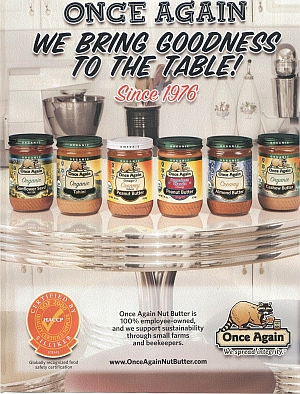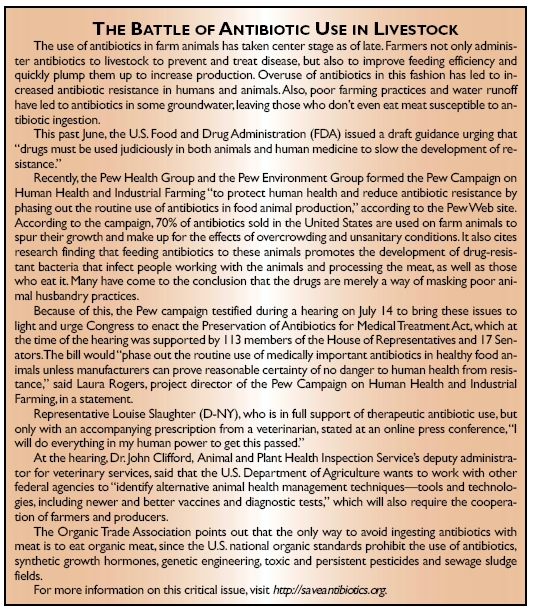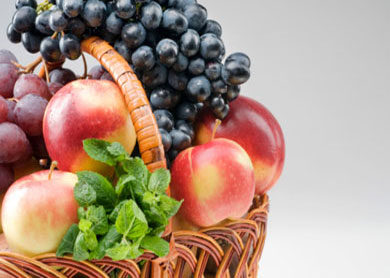To those who believed organic would be a passing fad and that the economy would deter organic growth, the numbers speak for themselves: 2009 sales of organics grew 5.1% over 2008 figures (1). In 2009, 54% of total organic food sales were handled through mainstream grocers, club stores and big box retailers, while natural and specialty retailers represented 40% of sales. Direct sales through farmers’ markets, co-ops, community-supported agriculture (CSAs) and the Internet, as well as exports, covered the remaining 6% (1).
Organic food and beverage sales represented approximately 3.7% of overall food and beverage sales in 2009 (2). Amid this solid growth, there are some key issues affecting the organic food industry: perception, health and enforcement.
 Enthused, but Confused
Enthused, but Confused
Experiencing the highest growth in sales during 2009 were organic fruits and vegetables, up 11.4% over 2008 sales. Most notable, organic fruits and vegetables now represent 11.4% of all u.S. fruit and vegetable sales. This may be due to the perception that organic foods are more nutritious and healthier than conventional food products, a subject that is still hotly debated.
However, organic doesn’t always mean healthy. Troubling results from a study published in Judgment and Decision Making show that there exists a bit of consumer organic mania because the term “organic” is often misunderstood. The study concluded that participants’ judgments of calorie content relative to other brands were influenced by the organic claim; even though all participants had just read that one serving of the product contained 160 calories, the organic cookies received lower calorie judgments than did the conventional ones (3). In addition, the organic claim influenced participants’ consumption recommendations: the organic cookies were deemed more appropriate to eat more often than were the conventional ones. The results of this study imply that retailers must take a more active role in making sure customers know that organic speaks to a product’s production method, not necessarily its calorie or nutrient content.
Sara Loveday, marketing communications manager at White- Wave Foods, Broomfield, CO, says, “Consumers are confronted with a lot of information about food, so we know that one of the most important things we invest in is educating consumers.”
In addition, it seems that phrases such as the “Dirty Dozen” (fruits and veggies associated with more “risk” for pesticide levels, such as grapes, peaches, kale and apples, etc.) may not represent an accurate portrayal of which foods might be better to purchase as organic, and may even deter some people from eating fruits and vegetable altogether if a recommended organic variety isn’t available. At the request of the Alliance for Food and Farming, a consortium representing growers in California, an expert panel was formed to review the scientific validity of documents created by the Environmental Working Group (EWG) and the Organic Trade Association (OTA) concerning the health effects of pesticide usage and the nutritional value of organically grown food. The panel, comprised of five reputable scientists from diverse backgrounds, found that currently available scientific data do not present a convincing argument to conclude that there is a noteworthy difference between the nutritional quality of organically and conventionally grown food. They also found EWG’s evaluation methods to be excessive and claimed it was alarming that the EWG wouldn’t divulge its exact methodology so that others can duplicate their analysis and revaluate results.
 Teresa Thorne of Alliance for Food and Farming told WholeFoods, “Consumers have various reasons for consuming organic or conventionally grown produce and we strongly support their right to choose. Both growing methods produce wholesome and nutritious fruits and vegetables that consumers should be eating more of. Our overall message is simply this: We strongly support the consumers’ right to choose organic or conventionally grown produce, but they shouldn’t use the Dirty Dozen list when making those purchasing decisions. EWG themselves acknowledges their list is ‘not risk based.’”
Teresa Thorne of Alliance for Food and Farming told WholeFoods, “Consumers have various reasons for consuming organic or conventionally grown produce and we strongly support their right to choose. Both growing methods produce wholesome and nutritious fruits and vegetables that consumers should be eating more of. Our overall message is simply this: We strongly support the consumers’ right to choose organic or conventionally grown produce, but they shouldn’t use the Dirty Dozen list when making those purchasing decisions. EWG themselves acknowledges their list is ‘not risk based.’”
Related to consumer perceptions about nutrition, there has been recent controversy surrounding the draft Dietary Guidelines for Americans 2010. In oral testimony at a hearing conducted by the Advisory Committee preparing the latest version of the guidelines, OTA’s Executive Director and CEO Christine Bushway pointed out serious concerns with certain statements in the draft. For example, although the Dietary Guidelines statement on organic foods references only limited research on nutrient density, it draws the broad conclusion that “Our current understanding of conventional and organically produced foods indicate that their nutritional value and contributions to human health are similar.”
“These conclusions are neither grounded in current science nor relevant to the mandate of the Dietary Guidelines,” Bushway said, who also pointed out the statement’s conflict with the recent President’s Cancer Panel report regarding ways to reduce environmental cancer risk. “As released, the guidelines confuse the consumer, contradict the President’s own Cancer Panel, and do not enhance dietary recommendations,” she stated, requesting this particular reference be stricken from the guidelines or be revised to reflect the Cancer Panel’s recommendations.
An Organic-Science Alliance
The recent President’s Cancer Panel report suggests we eat foods grown without pesticides to eliminate the risk of cancer. The Ecstatic for Organic The organic food industry is actively growing and adapting to consumer desires and regulatory transition. The report focuses on the role of chemicals in setting the stage for cancer, and promoting the growth of early cancers, through their impact on the immune system and basic metabolic processes, in the months prior to their conception, during fetal development and in the first two years of life. This implies that organic foods are especially important for kids and pregnant moms. According to Charles Benbrook, chief scientist at The Organic Center, exposure during these stages of life can trigger deviation from the foundation for a person’s immune system, which, later in life, can fail to combat early proliferative growth of aberrant cells.
The Cancer Panel’s message is “historic,” says Benbrook, because it breaks with 30 years of scientific dogma that holds that chemicals in the environment are not major causes of cancer.
According to Benbrook, “The best prevention for cancer is a healthy immune system, and reducing exposure to endocrine disruptors at the beginning of life is absolutely, unequivocally a necessary first step. Growing and consuming organic fruits and vegetables is one of the obvious, proven ways to lower exposures to a host of chemicals than can cause cancer or promote the growth of cancerous cell masses.”
 Additionally, the association between chemical pesticides and fertilizers and certain behavioral disorders has gained some strength. A recent study (4) published in Pediatrics examined the association between urinary concentrations of organophosphate metabolites and attention-deficit/hyperactivity disorder (ADHD) in children eight to 15 years of age. Results found that children with higher urinary dialkyl phosphate metabolite concentrations were more likely to be diagnosed as having ADHD. The study concluded: “These findings support the hypothesis that organophosphate exposure, at levels common among u.S. children, may contribute to ADHD prevalence.”
Additionally, the association between chemical pesticides and fertilizers and certain behavioral disorders has gained some strength. A recent study (4) published in Pediatrics examined the association between urinary concentrations of organophosphate metabolites and attention-deficit/hyperactivity disorder (ADHD) in children eight to 15 years of age. Results found that children with higher urinary dialkyl phosphate metabolite concentrations were more likely to be diagnosed as having ADHD. The study concluded: “These findings support the hypothesis that organophosphate exposure, at levels common among u.S. children, may contribute to ADHD prevalence.”
Benbrook believes “the link is strong in that powerful evidence from many types of research implicates pesticide exposure during pregnancy and in the first few years of life clearly as a risk factor for ADHD, autism, and a number of other neurological and behavioral disorders.”
Organic Integrity
Questions about the enforcement of and compliance with organic standards are pervasive, as these are the foundation for the integrity of the organic label.
Kent Spalding, vice president of marketing at Barbara’s Bakery, Petaluma, CA, notes, “As a manufacturer of organic products, we’ve found the national organic certification process to be rigorous and thorough, so we have no issue with market surveillance or additional agency inspections. We’re confident our certifying agency has excellent processes to ensure organic compliance.”
Others, however, feel that enforcement needs to be stepped up—inspections every few years leave a lot of wiggle room for an industry that is already under scrutiny. Simcha Weinstein, director of marketing at Albert’s Organics, a Bridgeport, NJ-based distributor of organically grown produce and perishable items, says, “Although this administration has already been quite favorable (not enough, but more so than most administrations in recent times) to the organic industry, there is still a considerable lacking of funds for the implementation of enforcing regulations. I like the idea of unannounced inspections.” He also notes that while some of the violations are attempts at gaming the system, some are just a lack of awareness by retailers as to how to correctly label their products (more on this, a little later). In addition, it is crucial that there be oversight of certifying agents responsible for reviewing organic operations.
Kathleen Merrigan, deputy secretary of agriculture for the uSDA told Whole- Foods in March, “We are beginning to conduct market surveillance of organic labels to ensure that organic products are properly labeled and certified. We are requiring additional unannounced inspections by organic certifying agents. unannounced inspections are a good way to maintain compliance with the standards. And, we are expanding the use of pesticide residue sampling to identify problems and improve organic integrity.”
A proposed budget of $3.1 million for the National Organic Program in 2011 implies that addressing the enforcement of organic standards can still be a priority. In a statement on the recent NOP Audit, uSDA Agricultural Marketing Service Administrator Rayne Pegg said, “Increased funding in the 2010 budget is allowing the NOP to increase its staff and resources to implement a number of improvements to the program. The NOP will audit more international operations and devote additional resources to enhance the accountability and enforcement of the organic standards” (5).
Another hot issue is legislation and certification surrounding genetically modified organisms (GMOs). A recent Supreme Court hearing (Monsanto vs. Geertson Seed Farms) demonstrated the importance of this issue as a nationwide concern, which resulted in the upholding of legislation preventing planting or selling GM alfalfa. This implies that genetic contamination from GMOs may still be considered harmful under the law, both from an environmental and economic perspective, a great re-enforcer for the organic industry.
Because the GMO issue is regularly in flux, many have taken it upon themselves to receive certification from a third party to verify that no GMOs exist in their products. For example, says Loveday, White- Wave will announce its enrollment in the Non-GMO Project’s verification program for its products including its organic Silk Soymilk products. The Non-GMO Project is a non-profit collaboration of manufacturers, retailers, processors, distributors, farmers, seed companies and consumers who share the belief that everyone deserves an informed choice about whether or not to consume genetically modified products and to ensure the sustained availability of non-GMO choices.
Organic Benefits Breakdown
Explaining the benefits of organic foods to consumers can be overwhelming, when faced with assumptions and misinformation. Weinstein, says, “It’s easy to wish that consumers were better informed, but it’s also not practical to believe that all consumers will take the time to thoroughly understand what organic is, or take the time to thoroughly understand most consumer- related issues. This is not a slam or insult to shoppers; it’s merely a statement of where we are at in our society. The focus is really on the retailers (the link with the consumers) to provide clear, simple and accurate information to their shoppers. The marketing challenge is to provide educational information to the customer that is brief, clear and memorable.”
Barbara Haumann, senior writer and editor for the Organic Trade Association, based in Washington, D.C., provides an easy breakdown of the key benefits associated with organic food production.
Environment:
• Organic farming helps prevent topsoil erosion, improves soil fertility, protects groundwater, conserves biological diversity and conserves energy.
• Because organic agriculture respects the balance of microorganisms in the soil, organic producers use composted manure and other natural materials, as well as crop rotation, to help improve soil fertility, rather than synthetic fertilizers that can result in an overabundance of nitrogen and phosphorous in the ground. As a result, organic practices protect ground water supplies and avoid runoff of chemicals that can cause “dead zones” in larger bodies of water. • Organic practices help safeguard the environment and protect habitats, so organic production conserves and promotes species diversity.
Health:
• Organic farming helps limit exposure to toxic chemicals from synthetic pesticides and fertilizers that can end up in the ground, air, water and food supply, and are associated with health consequences, from asthma to cancer.
• Organic practices recognize and respect the powerful nature of antibiotics. As a result, organic practices prohibit the use of hormones, antibiotics or other animal drugs in animal feed for the purpose of stimulating the growth or production of livestock. If an antibiotic is used to restore an animal to health, that animal cannot be used for organic production or be sold, labeled or represented as organic. Thus, organic practices avoid the abuse of antibiotic that could have profound consequences for treatment of diseases in humans. Growing crops in healthy soils results in food products that have healthy nutrients. There is increasing evidence that organically grown fruits, vegetables and grains offer more of some nutrients, including vitamin C, iron, magnesium and phosphorous, and less exposure to nitrates and pesticides residues than their counterparts grown using synthetic pesticides and fertilizers.
• Organic agriculture minimizes children’s exposure to toxic and persistent pesticides in the soil in which they play, the air they breathe, the water they drink and the foods they eat.
non-GMO Choice:
• Because U.S. national organic standards and industry practices do not allow the use of genetic engineering in the production and processing of organic products, organic agriculture gives consumers who wish to avoid genetically modified foods a choice in the marketplace.
Retail Compliance
Manufacturers are responding to consumer desire for organics, creating more organic varieties of products. Spalding says, “It is a continual challenge to cost-effectively source organic ingredients and we ultimately defer to customer demands when making any ad justments to our product line. So, if the demand for an organic product is strong, we will do all we can to keep it on the shelves at an affordable price.” More than a third of the 2010 Barbara’s Bakery lineup is made with organic ingredients including fruit juicesweetened cereals, granola bars, cookies and crackers.
justments to our product line. So, if the demand for an organic product is strong, we will do all we can to keep it on the shelves at an affordable price.” More than a third of the 2010 Barbara’s Bakery lineup is made with organic ingredients including fruit juicesweetened cereals, granola bars, cookies and crackers.
Think manufacturers are the only ones responsible for keeping organic foods in compliance? Think again. The chain of compliance continues into the retail store, and retailers are responsible for keeping up this standard on their end. Retailers can also be held liable for handling organic products out of compliance. According to the OTA, here are some key points from for retailers handling organic foods:
Retailers cannot knowingly sell a product labeled organic unless it meets NOP requirements. They are subject to fines up to $10,000 per violation. Although retailers are not required to be certified, they do, however, have the responsibility of preventing comingling and contamination of organic products with prohibited substances and of keeping records that show products marketed as organic have been correctly handled from production through delivery to the customer. Contamination is defined as direct contact of the organic product with prohibited materials (for instance, a prohibited fungicide or cleaning agent that might be inadvertently sprayed on organic produce).
As an example, retailers must store wet organic produce above wet conventional produce to prevent dripping onto the organic produce during misting or storage of iced produce. Retailers must take steps when using a substance or container that could potentially put a contaminant in contact with organic produce. There is no need, however, for separate storage or refrigeration units so long as organic product is clearly identified.
Knowing which certifications and paperwork you need can be tricky. When retailers produce organic products off-site to be sold in their stores or sold to other businesses, this qualifies as processing. Under the regulations, processors must be certified. Additionally, ask for suppliers’ paperwork (receiving records such as bills of lading, invoices and cash purchase receipts) and check the NOP Web site for the decertified list. If you are purchasing directly from the producer, ask for a copy of the certificate and product verification form if available. If you’re purchasing from a distributor, the distributor will keep the records. The retailer only needs to keep the invoice or packing slip from the distributor with the organic items clearly marked. This is part of your record-keeping requirement. The distributor may not need to be certified. The farmer provides his or her certificate to the first handler. Who keeps a copy for his or her records. If the distributor or produce shipper is certified, the retailer only has to get a copy of the organic certificate of the shipper. Make a record of when you receive product (keep a list) from this supplier.
Also, organic products from outside the United States that are sold domestically have the same requirements as produce grown and products made in the United States, including certification by a USDA-accredited agency.
Haumann recommends that retailers become familiar with national organic standards and also advises hiring a knowledgeable expert to get up to speed or to train employees, suggesting a list of consultants on the OTA’s searchable directory, www.theorganicpages. com.
Don’t hesitate to refer to the manufacturers of organic products for assistance, too. Spalding says, “We provide our retailers with precise information about our products’ ingredient and organic status. Excellent, clear communication between manufacturers and retailers is a huge part of successfully supporting organic products at the retail level.” WF
References
1. The Organic Trade Association, www.ota.com/organic/mt/business.html, accessed August 4, 2010.
2. The Organic Trade Association, 2010 Organic Industry Survey
3. J. Schuldt and N. Schwarz, “The ‘Organic’ Path to Obesity? Organic Claims Influence Calorie Judgments and Exercise Recommendations,” Judgment and Decision Making 5(3), 144–150, 2010
4. M. Bouchard, et al., “Attention-Deficit/Hyperactivity Disorder and Urinary Metabolites of Organophosphate Pesticides,” Pediatrics, published online May 17, 2010, accessed August 9, 2010. 5. USDA Press Release, “Statement from Agricultural Marketing Service Administrator Rayne Pegg on National Organic Program Audit,” March 18, 2010.
Published in WholeFoods Magazine, September 2010









